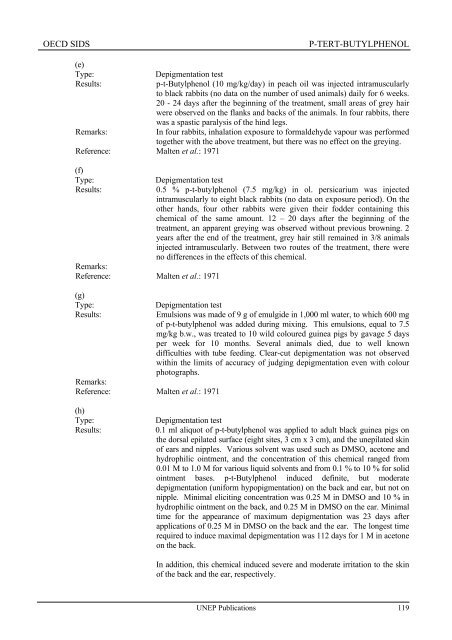p-Tert-Butylphenol - UNEP Chemicals
p-Tert-Butylphenol - UNEP Chemicals
p-Tert-Butylphenol - UNEP Chemicals
You also want an ePaper? Increase the reach of your titles
YUMPU automatically turns print PDFs into web optimized ePapers that Google loves.
OECD SIDS P-TERT-BUTYLPHENOL<br />
(e)<br />
Type: Depigmentation test<br />
Results: p-t-<strong>Butylphenol</strong> (10 mg/kg/day) in peach oil was injected intramuscularly<br />
to black rabbits (no data on the number of used animals) daily for 6 weeks.<br />
20 - 24 days after the beginning of the treatment, small areas of grey hair<br />
were observed on the flanks and backs of the animals. In four rabbits, there<br />
was a spastic paralysis of the hind legs.<br />
Remarks: In four rabbits, inhalation exposure to formaldehyde vapour was performed<br />
together with the above treatment, but there was no effect on the greying.<br />
Reference: Malten et al.: 1971<br />
(f)<br />
Type: Depigmentation test<br />
Results: 0.5 % p-t-butylphenol (7.5 mg/kg) in ol. persicarium was injected<br />
intramuscularly to eight black rabbits (no data on exposure period). On the<br />
other hands, four other rabbits were given their fodder containing this<br />
chemical of the same amount. 12 – 20 days after the beginning of the<br />
treatment, an apparent greying was observed without previous browning. 2<br />
years after the end of the treatment, grey hair still remained in 3/8 animals<br />
injected intramuscularly. Between two routes of the treatment, there were<br />
no differences in the effects of this chemical.<br />
Remarks:<br />
Reference: Malten et al.: 1971<br />
(g)<br />
Type: Depigmentation test<br />
Results: Emulsions was made of 9 g of emulgide in 1,000 ml water, to which 600 mg<br />
of p-t-butylphenol was added during mixing. This emulsions, equal to 7.5<br />
mg/kg b.w., was treated to 10 wild coloured guinea pigs by gavage 5 days<br />
per week for 10 months. Several animals died, due to well known<br />
difficulties with tube feeding. Clear-cut depigmentation was not observed<br />
within the limits of accuracy of judging depigmentation even with colour<br />
photographs.<br />
Remarks:<br />
Reference: Malten et al.: 1971<br />
(h)<br />
Type: Depigmentation test<br />
Results: 0.1 ml aliquot of p-t-butylphenol was applied to adult black guinea pigs on<br />
the dorsal epilated surface (eight sites, 3 cm x 3 cm), and the unepilated skin<br />
of ears and nipples. Various solvent was used such as DMSO, acetone and<br />
hydrophilic ointment, and the concentration of this chemical ranged from<br />
0.01 M to 1.0 M for various liquid solvents and from 0.1 % to 10 % for solid<br />
ointment bases. p-t-<strong>Butylphenol</strong> induced definite, but moderate<br />
depigmentation (uniform hypopigmentation) on the back and ear, but not on<br />
nipple. Minimal eliciting concentration was 0.25 M in DMSO and 10 % in<br />
hydrophilic ointment on the back, and 0.25 M in DMSO on the ear. Minimal<br />
time for the appearance of maximum depigmentation was 23 days after<br />
applications of 0.25 M in DMSO on the back and the ear. The longest time<br />
required to induce maximal depigmentation was 112 days for 1 M in acetone<br />
on the back.<br />
In addition, this chemical induced severe and moderate irritation to the skin<br />
of the back and the ear, respectively.<br />
<strong>UNEP</strong> Publications 119
















